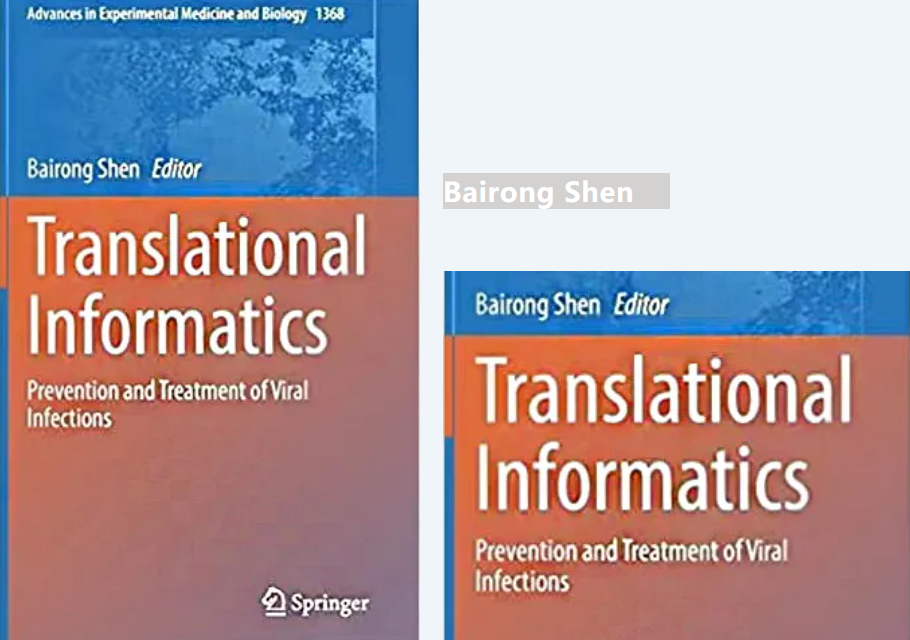Translational Informatics for the Prevention and Treatment of Viral Infections — Professor Shen Bairong's Latest Work

Bairong Shen
Viral infections are a significant issue in the field of public health. Over the past two decades, events like SARS, MERS, and the ongoing COVID-19 have caused tremendous losses to our society. We will continue to face the threat of viral epidemics as viruses co-evolve with us and adapt quickly to new environments. Additionally, the transmission of viruses between species may lead to new pandemics. With the development of 5G and artificial intelligence, data- and information-driven approaches to combating viral infections are gaining increasing attention. Professor Shen Bairong's research team presents a systematic introduction to the application of translational informatics in combating viral infections in their latest publication, "Translational Informatics: Prevention and Treatment of Viral Infections." The book covers tracking the origins of viruses, detection and prevention, drug discovery and vaccine design, and virus monitoring and control based on smart cities. It includes data mining and modeling at various levels, from chemical molecules, biological macromolecules, tissues/organs, individuals, to populations. The book also introduces and reviews the study of immunological mechanisms, personalized prediction for infected patients, and information-driven personalized treatment. It provides a perspective on the potential application of artificial intelligence in preventing viral outbreaks. This book is highly suitable for readers interested in virology, infectious disease prevention, bioinformatics, and medical artificial intelligence.
About the Editor
Bairong Shen is a professor and the executive dean of the Disease System Genetics Research Institute at West China Hospital of Sichuan University. He obtained his Ph.D. in Chemistry from Fudan University in 1997. In 1999, he was appointed as an associate professor of physical chemistry at Fudan University. In early 2000, Shen began his postdoctoral research at the University of Tampere in Finland, where he started new explorations in bioinformatics and related computational biology. His research and promotion of new paradigms in bioinformatics led to his successful tenure as an assistant professor/associate professor of bioinformatics at the University of Tampere. He established the Systems Biology Research Center at Soochow University in 2008. In Finland and China, Professor Shen has taught more than ten different courses in bioinformatics and systems biology and has published over 100 peer-reviewed articles in competitive journals, including cancer biomarker discovery, bioinformatics, and computational science. His recent research has mainly focused on bioinformatics and systems biology based on complex diseases and healthcare.
The book revolves around the following themes:
Viral Informatics Databases, Knowledge Bases, and Software Tools
Viral infections pose significant public health challenges due to their rapid spread and mutation.
Advances in bioinformatics have created opportunities for systematic modeling of viral biology.
The book introduces databases and knowledge bases related to viruses and emphasizes bioinformatics models and software tools for tasks such as multiple sequence alignment, evolutionary analysis, and whole-genome studies.
It discusses the application of data-driven and AI-assisted methods in viruses like SARS-CoV-2, HBV/HCV, and influenza, highlighting the importance of viral informatics in surveillance and public health.
Informatics of Virus Origin, Evolution, Detection, and Prevention
The pathogenesis of viral infections is complex, involving mutation, integration, and interactions with the host genome.
Bioinformatics methods, along with accumulated data and high-throughput sequencing platforms, aid in monitoring viral diversity and identifying potential pathogenic features for detection and diagnosis.
The book focuses on SARS-CoV-2, summarizing the use of bioinformatics tools in tracing virus origins and analyzing evolution, and overviews traditional and emerging techniques in detection and prevention.
The development of AI, machine learning, and deep learning provides advanced analytical techniques for uncovering key factors in viral infections and predicting disease risks.
Computational Simulation for Antiviral Drug Development and Vaccine Design
Computational methods for drug discovery and design have proven effective in addressing viral diseases.
The book discusses various methods and their application in developing antiviral compounds, including in silico screening, molecular docking, and ligand-based or pharmacophore similarity searches, followed by in vitro testing to determine biological activity.
It also outlines descriptive methods for managing common viral diseases and introduces the concept of immunoinformatics for vaccine design, focusing on the selection of antigens from pathogen genomes or proteomes for epitope-based vaccine strategies.
Disease Prediction and Modeling at the Population Level
Given the wide range of clinical severity in COVID-19 patients, there is an urgent need for effective risk factors, biomarkers, and models to predict disease severity and mortality, guiding clinical intervention and management.
The book presents characteristics of different COVID-19 strains, the potential of clinical features, cytokine storms, and biomarkers in predicting disease severity, and examines scoring systems, mathematical models, and AI-based models for COVID-19 infection prediction and severity classification at the population or individual level.
5G, Smart Cities, and Virus Prevention
With the development of urbanization, AI, communication technology, IoT, and GIS, cities have evolved to form smart cities, which integrate various aspects of resident life through the combination of 5G and big data.
The book introduces the current state of smart city research, including architecture, technology, and devices, and discusses the application of GIS in infectious disease research.
It also addresses the challenges and opportunities of explainable AI (XAI), an important next step in AI development, especially in healthcare, where the interpretability of AI models is crucial for patients and medical staff.
The role of smart cities in the context of viral infections, using COVID-19 as a case study, is discussed, along with current specific applications.
Publisher's link: https://link.springer.com/book/9789811689680

